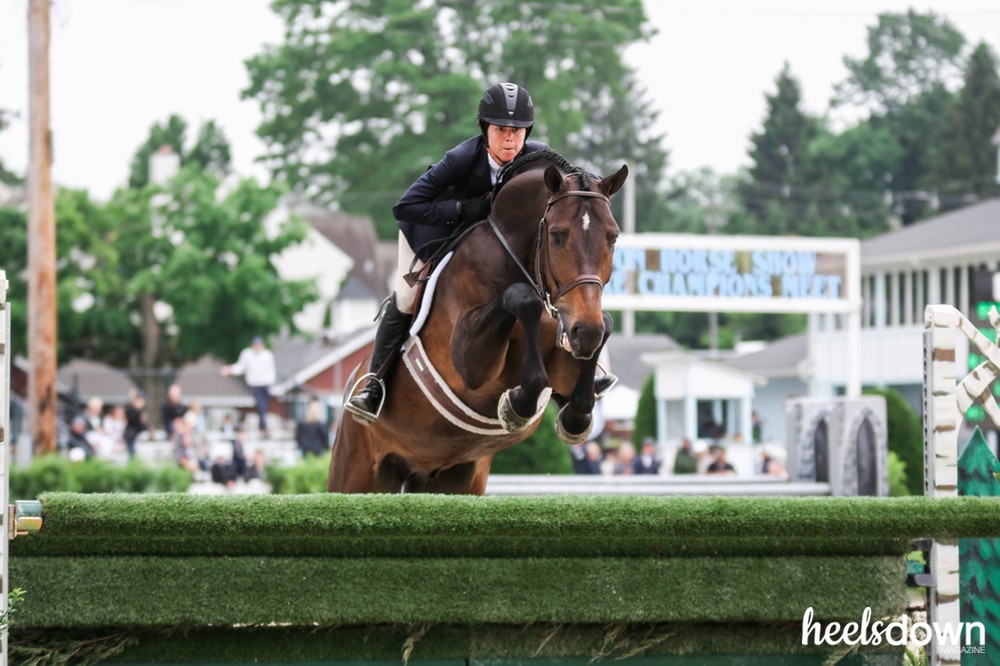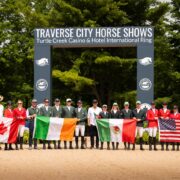Knees To Nose – Getting Scope

Some horses naturally have good jumping form. Some learn it over time. There’s no doubt that some horses are more scopey than others. But as riders, we can help teach our horses to use their bodies correctly over fences, and give off that perfect form with their square and level knees popping up to the height of their head.
“Some horses naturally have that good jumping in them, just in the way they are built,” said Terence Prunty, a professional hunter trainer. “You have some horses, that even as a young horse, you will free jump them or start them over small fences and they will already have that power and the scope in them. With that being said, there is a certain aspect in training where you can produce that kind of jump.”
Working on the muscles in the horse’s hind end is key, Terence explains.
“Making sure the hind end is really, really strong and making sure the balance is up,” is vital, he said. “If you have a horse whose balance is a little low on the forehand, it’s going to be harder to ask them to rock back, come up through the shoulder and jerk their knees up. So it can go a little bit of both ways. You can improve it with some exercises in the way you warm up your horse.”
Ride Correctly to Encourage Flair
Terence says riders can help their horse become more scopey over fences by enforcing correct and technical riding.
“You always want to ride your horse to the base of the jump. Give them a little bit of room but make sure you get up to (the base of the jump) so they can rock back and get their knees up,” he says. “What we do when we warm horses up is to usually start with a small square oxer. The goal is to get them to jump up but also across.
Once you do that, if you have a horse that the balance is a little bit low, you can start with a ramped oxer, so a little bit higher in the back. It gets them to bring the shoulder up and then create that bascule and that arc on top of the jump.”
Next, he suggests moving on to a vertical fence in the warm up.
“Ride them ‘up’ to get them to jump up. So you got them jumping across with the oxer, now you got them jumping up. Then we usually like to finish off with a 9-foot landing rail which gets them to finish the jump,” Terence describes. “As they come up to it, they’re jumping up and then they’re looking at the 9-foot landing rail so they start to come up with the wither on the back. That’s when you start to get that really high round jump.”
Practice Over Different Kinds Of Fences
Terence suggests riders school their horses over fences they would commonly see in the hunter ring, like jumps with rolltops, oxers, walls, brush boxes and flowers.
“You want them so they are relaxed when they go into the ring. When you have a relaxed horse, you get a better jump,” he explained. “We’ve had some hunters in the past that are so brave, that we don’t even jump them that much. You want them to be impressed but not backed off and spooky.”
Terence says he doesn’t jump his horses too high at when he’s practicing at home and instead works more on the fundamentals. He jumps his horses at home at least twice a week, and if he’s preparing for a horse show, maybe 3-4 times a week.
“We don’t jump the height they are going to jump in the ring for the most part. We’re really just working on straightness. If you have a straight horse, you’ve got a better jump for the most part. You want their knees to be even. You don’t want them to be drifting one way or the other,” he says.
“So we usually practice straight lines, jump all the jumps that they’re going to see in the ring and it kind of goes back and forth with what that horse actually needs. If it’s a horse that’s a little spooky, you want them to be comfortable with the jump. If you have a horse that’s naturally brave, just having a relaxed horse is the best.”



